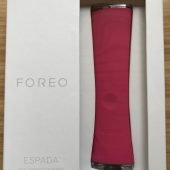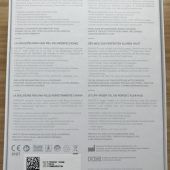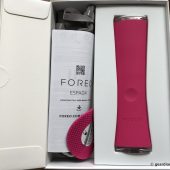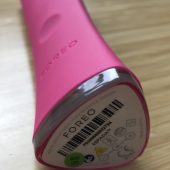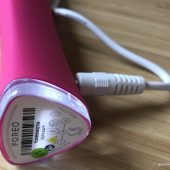Other than a few pimples and the typical blackheads, I never really had to deal with teen acne. Fast forward to my 20s, 30s, 40s, and now entering my 50s; while I still have relatively good skin, I deal with hormonal breakouts all the time. All. The. Time.
The FOREO ESPADA is supposed to help, but does it? Can it?
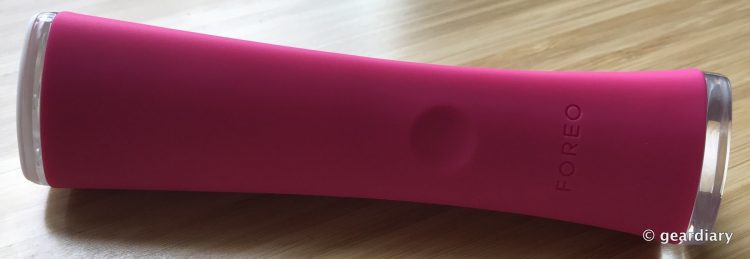
Foreo lists the main causes of acne as genetics, stress, diet, hormone imbalance, medications, and beauty routines. You can fix your diet and beauty routine pretty easily, but an acne treatment beyond simply keeping your face clean may be necessary for the other causes.
I’ve tried several different acne treatment devices over the years; some have been more helpful than others, but most of them involved applying a direct dose of heat to the affected area — which could be painful. Those devices also needed cartridges that had to be replaced after so many uses.
The Foreo Espada (forgive me, but if I keep typing it in all caps, we’re both going to feel like I am yelling at you) uses blue light acne therapy. It will never need replacement cartridges, it has a rechargeable battery, and one charge is supposed to last for up to 240 30-second uses.
What is this witchcraft?
Well, there’s actually sound science behind blue light acne therapy. A quick search at the American Academy of Dermatology‘s website pulls many articles. This one is free to view without a membership; under the heading ‘Procedures That Treat Acne’, it says:
Lasers and other light therapies: These devices reduce the p. acnes bacteria. Your dermatologist can determine whether this type of treatment can be helpful.
Acne.org says:
Light therapy refers to non-laser sources of light that help to some degree in preventing papules and pustules, the everyday “pimples” that many people get that are inflamed and red. Smaller lesions, such as non-inflamed whiteheads and blackheads, as well as severe acne lesions like nodules and cysts, respond more poorly. When light is shone on the skin, it penetrates through various skin layers and may help kill some acne bacteria or reduce some of the inflammation or excess sebum (skin oil) production that are characteristic of acne. Benefits of light therapy include low side effects, easy accessibility, and affordability. Drawbacks include incomplete, temporary, and often poor results, and difficulty in application. Even when light therapy does produce results, since light therapy will not clear acne completely, people normally use light therapy in conjunction with other acne therapies, with the exception of isotretinoin (Accutane), which must be used alone.1 Light therapy can be administered in a doctor’s office or at home.
And according to the-dermatologist.com:
Blue light kills the acne-causing bacteria known as Propionibacterium acnes, or P acnes, which can cause inflammation. P acnes is sensitive to blue light. Using the blue light, eliminates the bacteria found in the oil glands in the skin. The added presence of infrared light (heat) in the home device causes the oil glands to shrink in size. The result is less oil in the skin and less bacteria, leading to the resolution of acne in the treated areas.
Eliminating the bacteria from the skin with help from blue light decreases the inflammation associated with red pimples (papules) seen in acne. After a number of treatments, the blemishes disappear and skin regains its normal appearance.
So now that we know that the science behind the Foreo Espada is real, the question becomes “Does the Foreo Espada’s particular type of blue light acne treatment actually work?” That’s what I set out to find out with this review.
The box includes the Foreo Espada device, a USB charging cable, a storage bag, a quick start guide, and what appears to be a magnetic-backed scrubby to use when cleansing your face. Note that in the middle of the scrubby there is a removable sticker with a scratch-off area. Under the scratch-off is a unique code that you enter at foreo.com/support to activate your warranty and get a future purchase discount.
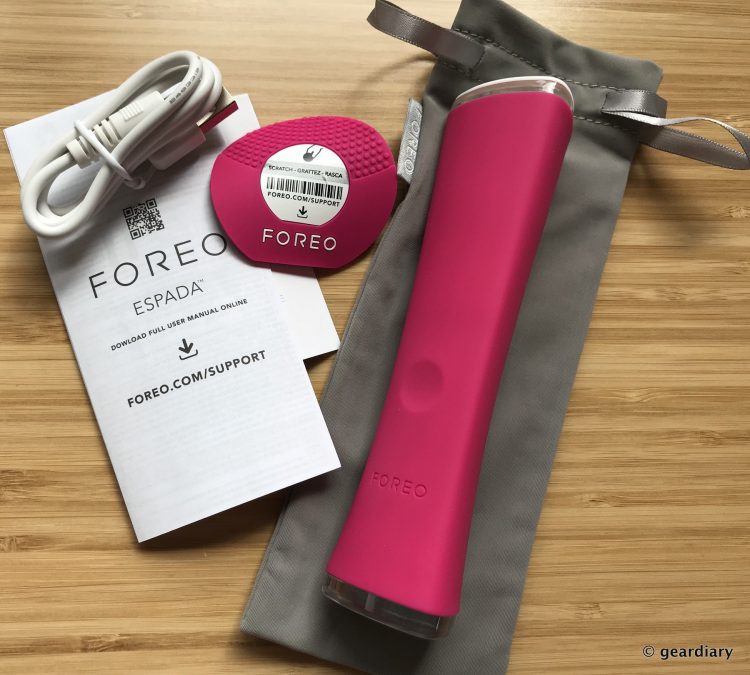
The Foreo Espada blue light acne treatment device measures approximately 5.5″ long by 1.25″ thick by 1.5″ thick, and it weighs 3 ounces; in other words, it is easy packable if you travel a lot. The Espada is composed of clear plastic and silicone; you can get the device in cobalt blue, pink, or the magenta I was sent. On the front of the device, there is an on/off button.
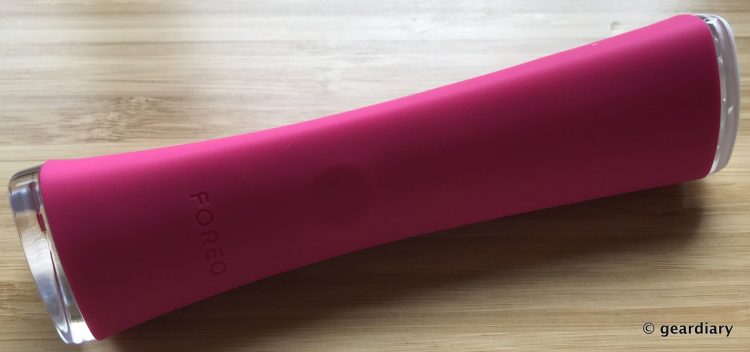
This is the business end of the Foreo Espada. The center lens is the treatment surface, and it is surrounded y a white antibacterial silicone triangle; this is the end that you will hold to your face or neck when treating acne.

The sides are plain …
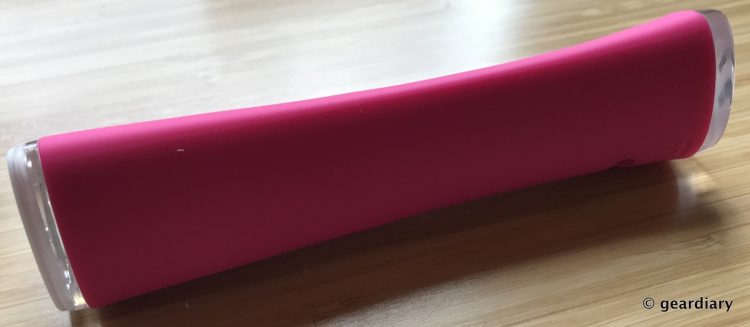
… and in the center of the back edge, there is a round charging port.
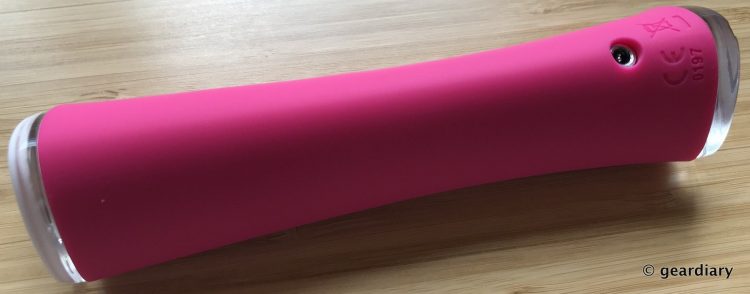
The bottom of the Foreo Espada is a clear piece of plastic; it will blink white as the device charges and glow solidly white when charging is done.
The Foreo Espada is not meant to be used on severe, nodular, or cystic acne; if you suffer from that, it is best to see a dermatologist and explore other options. If you have mild to moderate inflammatory acne (anything from white/blackheads or papules, to inflamed, sensitive bumps filled with pus), the Foreo Espada is made to help.

Foreo says that:
Acne is a skin condition that causes protrusions varying in size and appearance depending on their category. Whiteheads remain below the skin’s surface and are white in color; blackheads emerge from the surface and form a black bump; papules are small inflammations that are pink; pustules (most commonly known as a “pimple”) are red and inflamed with puss on the top; and cysts/nodules are painful inflammations that remain deep in the skin. Acne forms when the pores of the skin are clogged with excess oil and dead skin cells, causing acnes bacteria to proliferate.
Here’s how the Foreo Espada works:
1. The blue light activates when device touches the skin to kill bacteria. It flashes 3 times to indicate the start of the 30-second treatment in Steady Mode. If moved from the skin the light automatically turns off. the
2. T-SONIC™ pulsations start to stimulate blood microcirculation, facilitating the skin’s renewal. They begin when the device is placed on the skin and gradually increase in speed until the treatment is finished.
3. A targeting light (red cross-shaped light) targets the exact spot you wish to apply treatment. It’s active when the device is away from the skin, and it turns off when the device touches the skin. BUILT-IN TIMER Pauses pulsations once every 30 seconds to indicate the end of 1 blemish-treating routine. After the pause is felt, the device should be moved to the next treatment spot
4. A built-in timer pauses pulsations once every 30 seconds to indicate the end of 1 blemish-treating routine. After the pause is felt, the device should be moved to the next treatment spot
Before putting the Espada on your face the first time, Foreo recommends that you try it on another patch of skin — like your inner arm — and wait 24 hours to make sure you don’t have any kind of reaction. This is a normal and sane precaution.
Assuming you don’t have a reaction, you’re ready to use the Espada on your face.
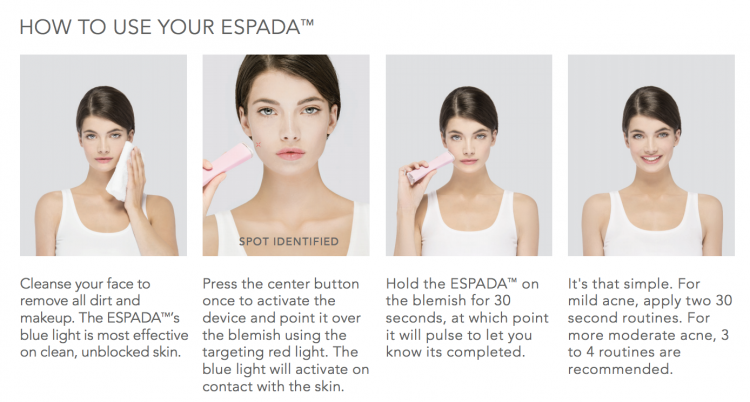
It really is as simple as the graphic says: you hold the Espada to your face while the blue light pulses and the device vibrates on your skin. When you are done with that area, you can move the Espada to another spot on your face and it will start the process over and over. Each treatment lasts 30 seconds, and if you have mild acne, that may be enough for that particular spot. If you have more moderate acne, you might want to treat the same spot as many as three or four times (up to a max of two minutes on that spot).
It’s possible that you may see or feel one or more of the following after a treatment:
• SKIN WARMTH: The skin may feel warm during treatment, which is not any cause for concern as it is normal.
• TEMPORARY SKIN REDNESS: The skin may develop a slight redness that fades within 24 hours.
• TEMPORARY SKIN DISCOLORATION: If the skin develops a slight discoloration that lasts more than
24 hours, stop using the ESPADA™.
There are also some common sense warnings:
• If you have medical concerns, you should talk to a dermatologist before using the Espada.
• As I mentioned previously, the Foreo Espada is not meant for severe, nodular, or cystic acne.
• You should not use the device or let it come into contact with injured skin or skin that has undergone surgery.
• You shouldn’t use the Espada on beauty spots/moles, warts, ingrown hairs, or irritated skin.
• You shouldn’t use the device if you are particularly sensitive to light.
• You shouldn’t use the device on your face if you’ve had a sunburn within the past two weeks.
• You shouldn’t use the device in and around the eye or lip area.
• If you don’t want to injure or burn your skin, then you shouldn’t apply the Espada to treat the same spot more than 3 times in a day; you need to leave a minimum of 4 hours in between each treatment.
• You shouldn’t treat the same spot for any longer than 2 minutes (4 cycles in a row); if you overuse the device, you can injure your skin.
• The device will get hot if you use it excessively; if it gets too hot, it can cause skin redness (I haven’t used it enough in one session for it to even get warm).
• If you use the device and then notice that your skin feels tense, uncomfortable, or irritated (beyond just a mild bit of redness), you should stop using the Espada and talk to your dermatologist.
• You should never look directly at the blue light as it can injure your eyes.
• Keep children away from the Foreo Espada; it’s not a toy, and it could harm their eyes. Don’t use it on a child’s skin, as it may cause temporary redness or hypo- and hyperpigmentation.
• People with reduced mental or physical abilities may require extra supervision or instructions before they use the device.
• You should never share the Espada with other people — you don’t want to transfer bacteria from one person to another.
• You shouldn’t use the device if it appears to be damaged, and you should never try to open the device to “repair” it. One of the reasons for this is that it can result in a serious eye or skin injury, or it could lead to a (possibly) fatal shock.
• You shouldn’t use the Espada if you are pregnant or breastfeeding.
• If you’ve had a migraine in the last two years, then you shouldn’t use the Espada.
• You should not use the device over a thyroid gland, as it might result in growth stimulation.
• If you are taking drugs or steroids for pain or skin conditions that cause light sensitivity, then you shouldn’t use the Espada (it could result in a photosensitive reaction).
• If you’ve had a steroid injection within the last 6 months, you should not use the Foreo Espada near that site.
I’ve been using the Foreo Espada on my face for about a month, and I’ve noticed that if I have a little pimple popping up, a couple of treatments with the Espada coupled with my normal skin cleansing routine seems to stop it in its tracks (!!). It doesn’t hurt to use the device, and I don’t seem to have any ill side effects. Over time, I have noticed that I have fewer blackheads on my nose and chin (gross, right?), and the pores on my chin and nose look smaller and tighter. I’m calling that a win!
If you want to see a variety of owners’ reviews, take a look at the comment section on the Espada’s listing at Sephora. The reviews look pretty well-rounded with both the good and any bad.
The only maintenance that the Foreo Espada requires beyond charging occasionally is that they recommend you clean its treatment surface after each use. You can use soap to clean the device, then rinse it with warm water and dry it with a lint-free cloth.
If you suffer from mild to moderate acne — and by that, I mainly mean pimples and blackheads — then you know how tempting it is to use your fingernails to try to extract that pore’s contents. Beyond the fact that this is gross and unsanitary, doing this can lead to bleeding, possible infection, and sometimes scarring. We’ve all done it, but there is a better way to handle acne: use the Foreo Espada to calm your skin down. Give it a couple of days (don’t expect overnight results, though you may get them), and you will notice that your blemishes are shrinking then disappearing.
[I will be putting a Foreo Espada in each of my daughter and step-daughters’ stockings this Christmas; I think that they will love it!]
The FOREO ESPADA retails for $149, and it is available directly from the manufacturer and from other retailers including Amazon [affiliate link]. The Espada comes with a 2-year warranty and 10-year quality guarantee.
Source: Manufacturer supplied review sample
What I Like: Easy to use; Holds a charge for a long time; Great to travel with; Easy to clean; Doesn’t dry out my skin after treatment has been applied; It really helps!
What Needs Improvement: This isn’t going to replace your regular skin maintenance; The treatment head isn’t large, and using the Espada isn’t as convenient as going to a dermatologist and having them do your whole face at once, but for the money that you’ll save and the fact that you can do it at home? Worth it.

